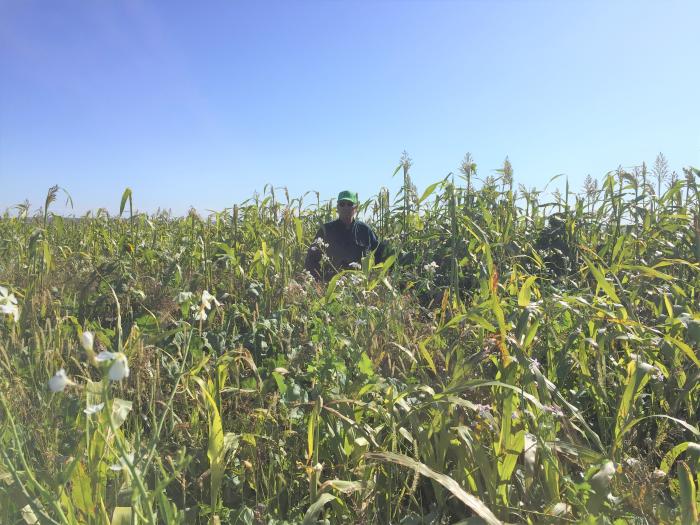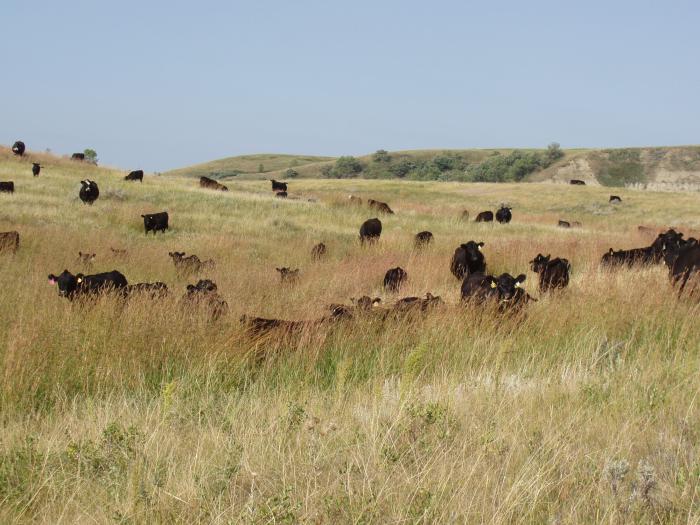Morton County Rancher Triples Stocking Rates with Aid From NRCS
When Ken Miller started farming in the 1970s along the Missouri River cut banks in Morton County, he quickly encountered a problem.
Luann Dart writes from Elgin, N.D.
“It’s some real fragile land. It varies so much, from bentonite to clay pan to pure sand, so wind erosion and water erosion were a big item back in the tillage days. Back then, I knew I had to change the way we were farming. We wouldn’t have been here very long,” he explained.

The solution, however, would take some time, and the assistance of the USDA Natural Resources Conservation Service (NRCS) in Morton County.
With small grains, hay production and a cow/calf operation, Miller first switched to no-till in 2001.
“The biggest change was when we quit tilling and went to no-till. But just quitting tilling wasn’t the total answer either. We had to change our crop rotation,” he said.
Miller started downsizing his rented acreage, and added corn, soybeans and field peas into his crop rotation.
In 2006, he added cover crops to the mix also, either planting cover crops after the harvested cash crop or as a full-season cover crop.
At the time, Miller was working for the Burleigh County Soil Conservation District, where he learned more about soil health and the benefits of cover crops.
“We were doing that on very good soils and I was quite skeptical trying it at home here, but when I started, I could really see the benefits,” he said. “You start building the soil biology and start getting that balance and that’s when things really start happening above ground.”
He incorporated full-season cover crops to heal the soil, planting a cool season mix in the spring and a warm season mix in June, then grazing those fields.
Eventually, Miller started switching all of his cropland into rangeland, using assistance from the Environmental Quality Incentives Program (EQIP) through the NRCS.
He’s transitioned 400 acres of cropland into a diverse mixture of grasses for rangeland.
In the mid-1980s, he started an intensive rotational grazing program, starting with 18 paddocks about 40 acres each. Today, his system includes more than 60 paddocks of native and cool season grasses, each about 20 acres in size. His 150 head of cattle graze in each paddock for one to three days, depending on the grass growth. Each paddock is generally only grazed once each season.
He added 14 water tanks for fresh water, four miles of pipeline and seeded 400 acres back to a diverse mixture of grasses and legumes under the NRCS program. He also added 30 miles of cross fence.
“A lot of these things wouldn’t have happened without their assistance,” he says of NRCS.
His stocking rate has increased threefold since the 1980s. On the poorest soil, Miller planted a warm season cover crop mix five years in a row, then grazed it to get the soil biology back in balance. He then seeded these fields to a diverse mixture of grass and legumes.
“What is significant about his accomplishments is that he was typically the first person to try these new things in the area, such as intensive grazing and cover crops. In agriculture, that can be tough to do because your operation is on display, in a sense, and a failure (or success, in this case) can really stand out and be costly,” said Brandon M. Schafer, Watershed Coordinator for the Morton County SCD. “NRCS was best able to assist him through financial assistance to reduce the risk involved with implementing new practices and providing advice/technical assistance where it was needed.”
Through his work with the Burleigh County SCD, Miller also discovered that a diverse mix of plants will thrive.
The SCD had planted 30-foot strips on a five-acre plot. One plot included single species, and another was a mixture of six to eight different plants. During a dry year, the mixture of plants thrived.
“Where they were planted alone, they were dead and where they were in a total mix 300 feet over, they were thriving, so that told a tremendous story that plants were collaborating and not in competition,” Miller said.

“Once we started doing the mixes, that’s when things really changed,” he said. He now plants eight to 12 plants together, such as legumes, turnips, radishes, sunflowers, legumes and grasses.
Over the years, Miller also implemented other practices, including switching to smaller-framed Angus cattle, weighing from 1,100 to 1,200 pounds.
“They’re a lot more efficient to get through the way we graze, too,” he said.
He also now calves in June.
“That took me 20 years to change that,” he said with a laugh. But with both him and his wife, Bonnie, working off the farm at the time, it made more sense.
“We had to make ranching as simple as possible,” he said. “It’s a lot easier and it’s a lot more profitable. You don’t have the sickness and you take the stress away. Our vet bill is almost nothing. You don’t have to be with the cattle when they calve; they do just fine.”
Calves are left with the cows through the winter, then are weaned in March and sold as yearlings in July.
Miller has also changed his winter-feeding habits, grazing eight to nine months and feeding three to four months each year, compared to six months grazing, six months feeding years ago.
“That makes a big difference on our bottom line,” he said. “We stockpile a lot of grass and try to winter graze as much as we can.”
Miller accomplishes his winter feeding by using “bale grazing,” in which 11 weeks of hay is placed in paddocks once a week. When hay is consumed in one paddock, a gate is opened, and the cattle are moved to the next pile of hay.
Bale grazing cuts back on winter labor and leaves the manure in the pastures, rather than a corral. The bale grazing is done on poor soils, which helps improve production on that land, Miller said.
He points to a study at the Central Grasslands Research Extension Center near Streeter which is monitoring bale grazing. It’s revealed that production on the grassland is two or three times better where bale grazing occurred. Where he’s bale grazed, Miller also broadcast seeds a mixture of clover and grasses to help the land return.
Miller has also utilized the Conservation Stewardship Program (CSP) through NRCS, which rewards conservation practices, like planting a pollinator plot; seeding the last of his cropland to grasses; and monitoring rangeland. The intensive monitoring of grass growth gives him a perspective of how his management practices are working.
“It makes you aware of when you should be grazing. Every year is different, so you always have to be changing,” Miller said.
Now retired from the SCD, Miller was a recent winner of the North Dakota Leopold Conservation Award, which honors North Dakota landowner achievement in voluntary stewardship and management of natural resources.
With the expertise of NRCS, Miller recommends other ranchers consider high-intensity grazing, starting on a small number of acres to witness the transformation of grasslands. Tackling erosion problems, poor soil health and failing grasslands takes patience and time, Miller said. But he’s witnessed the results of long-term care himself.
“Most of this land should have never been farmed in the first place,” he said.

